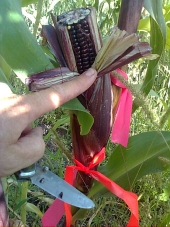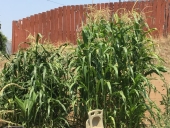


10 Podcast Review of the book Just Enough by Azby Brown
will be released to subscribers in:
soon!



 2
2




 2
2




pax amor et lepos in iocando
 1
1




Melissa Ferrin wrote:I have no idea how much corn you planted, but unless just a small row, it's highly unlikely the caterpillar(s) can eat it all before the caterpillar moves on to the next stage of its life, which should be within the next month I'd think in Missouri. Leave some on the stock. Again, not knowing how much you planted nor how much seed you want, Maybe leave 5-10 percent of your ears and stocks standing to harvest your seed.

 4
4




 2
2




sow…reap…compost…repeat
 3
3




Eric Hammond wrote:I’ve never grown corn before, I planted some sweet corn July 1st and it looks ready to eat.
I peeled one back a bit and there was a caterpillar eating the top. I assume you just cut the top off and eat it anyway?
Eric Hammond wrote:
Anyways my real question is, if I want to save seed from this, I can’t just leave it on the stalk can I? Will the caterpillar eat all the corn and leave me with no seeds? What exactly do I need to do here?
Nothing ruins a neighborhood like paved roads and water lines.
 2
2




 2
2




Tereza Okava wrote:but I suspect it has more to do with coincidence- weather, wind, etc probably determine more when and where the worms appear. Still, maybe you'll learn something! keep us posted!
Nothing ruins a neighborhood like paved roads and water lines.









 1
1




Dirty hands + a sweaty handkerchief = hope for the future.




Eric Hammond wrote:is it safe to assume all the corn I see for sale is sprayed with some sort of pesticides?
 2
2




Dirty hands + a sweaty handkerchief = hope for the future.
 1
1




Cy Cobb wrote:I forgot to mention, if you are only interested in saving enough corn seed for next year's crop, rather than breeding for improvements, then you could try this:
Cut off the ear worm damaged end of the cob at the same time that you are shucking the corn husks for eating or freezing. Save the damaged ends in a shallow cardboard box such as a beer flat or printer paper box lid. Place the box in front of a fan in a warm garage or other outbuilding away from flies if possible (if not possible, just leave to dry outside, but out of the rain). Once dry enough (a couple weeks), gently press your thumb on a kernel & it'll pop off. Do this to all of the clean mature kernels (emphasis on mature) and put them in an open top paper bag or small cardboard box to finish drying for storage. Once hard & dry enough to shatter when hit with a hammer, you can store the seed in a glass jar for next year's planting.
If you do the math, you'll find that for every 1 seed you plant, you'll get 1-2 ears. From those 1-2 ears, you'd normally throw the damaged tips away when husking. If you save & dry those damaged tips, you could get anywhere from 10-20 good seeds from each one. So, you'll have enough dry seed this way to potentially grow two back to back crops (depending on your growing season) with seed left over to give your neighbors.
For small plots, you could get away with this for a couple years I'd think before needing to introduce fresh seed due to inbreeding depression.

 2
2






|
We've gotta get close enough to that helmet to pull the choke on it's engine and flood his mind! Or, we could just read this tiny ad:
The new purple deck of permaculture playing cards
https://www.kickstarter.com/projects/paulwheaton/garden-cards
|





